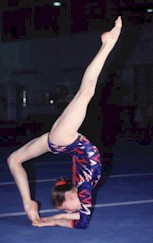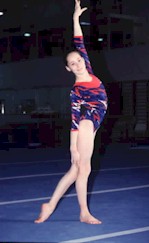 | ||
 |
||
|
| ||
 |
|||||
Gymnastics Characteristics of the Sport Gymnastics embodies six different and unique disciplines: sports acrobatics, rhythmic gymnastics, sport aerobics, trampoline sports, and men's and women's artistic gymnastic programs which involve junior and senior athletes. As there are very different demands across gymnastic disciplines, this fact sheet will focus specifically on artistic gymnastics. Training Elite gymnasts train in excess of 20-30 hours per week. Typically, daily training sessions are scheduled morning and afternoon lasting for 2-3 hours each. During training sessions, gymnasts repeatedly practise entire routines or a skill or sequence within a routine, develop new skills, improve strength and flexibility and assist in choreographing routines. Competition Women's artistic gymnastics involves competition over four individual apparatus - vault, uneven bars, balance beam and floor exercise. The men compete over six individual apparatus including the floor exercise, pommel horse, rings, vault, parallel bars and high bar. Most men's apparatus involve activity for 20 to 50 seconds and involve short bursts of explosive power and strength. The floor exercise lasts from 50 to 70 seconds and creates the highest anaerobic demands for both men and women. In women's gymnastics, the balance beam usually takes one and a half minutes, while the vault is completed in a matter of seconds. Technical skill perfection, muscular strength, explosive power relative to body weight, flexibility and artistic impression are all essential characteristics required for world class performance. Gymnasts have to be sixteen years of age in the year of competition to be eligible to compete in major international events such as the Olympics and World Championships. In order to possess the required skills for international success at the minimum eligible age, gymnasts start intensive training at a young age. With each four year Olympic cycle, new skills are introduced to international competition and graded according to their degree of difficulty, safety and aesthetic value. Being the first gymnast to introduce a new skill to international competition often results in having the skill named after the gymnast (e.g. the "Korbut:). All gymnasts compete in team qualification competition, as all-round competitors or individual apparatus competitors. Teams consist of six gymnasts with five of the six contesting each apparatus. The four highest scores from each team, for each apparatus, count towards the final team score. From this initial qualifying round, gymnasts and teams are ranked for the finals competition. Depending on the gymnast's level of skill and overall standing within their team, they may compete in all three competitions or compete solely on one apparatus. Physical characteristics Physical attributes necessary for competition success in female gymnasts have significantly changed over the past thirty years. The progressive increase in the difficulty of skills since the 1950's and 60's has increased the physical demands and the acrobatic nature of the sport. Today's elite female gymnasts are small, lean (low percent body fat), and well muscled which results in a high power-to-weight ratio. Generally, female gymnasts reach their peak power-to-weight ratio prior to puberty and are ready for elite international competition at the minimum age requirement. Male gymnasts have also changed over the years and are now smaller than the gymnasts of the 1950's. Male gymnasts are lean and heavily muscled, yet possess adequate flexibility and agility to perform the required skills at elite international competition. Modern successful male gymnasts have a high power-to-weight ratio which is normally reached during their twenties which makes them somewhat older than elite female gymnasts. Common Nutrition Issues Adequacy of Daily Energy and Nutrient Intake As female gymnasts develop into elite senior competitors, they receive regular assessment of body weight and body fat levels in order to maintain a lean, muscled physique. Consequently, female gymnasts typically consume diets low in energy (kilojoules), placing them at risk of inadequate nutrient intakes such as carbohydrate, calcium and iron. It is important for female gymnasts to eat nutrient-rich, low-fat foods at meals and snacks in order to meet their daily nutrient needs. High fat snacks (i.e. chocolate, pastries, potato crisps) and nutrient-free carbohydrate foods and fluids (i.e. soft drinks, lollies) are not encouraged as regular snack foods, but rather as occasional food choices. Unlike female gymnasts, male gymnasts usually consume diets high in energy to ensure they maintain muscle mass and promote muscle development when necessary. Many adolescent male gymnasts struggle to consume enough food to keep pace with the added demands of growth and training. As a result, male gymnasts routinely supplement their dietary intake with energy-dense, nutrient-rich snacks and fluids such as liquid meal supplements to keep pace with daily fuel needs. Between Meal Snacks Gymnasts have a busy lifestyle, juggling training with school, university or work commitments. Consequently, most gymnasts snack on the move - on the bus between training and school or in the car on the way to work. Choosing nutrient-rich snacks that provide adequate energy and are rich in carbohydrate and protein is crucial for gymnasts aiming to maximise their recovery between training sessions and meet their daily nutrient requirements. Excellent 'on the move' snacks include low-fat fruit yoghurt, fresh and dried fruit, lean cold meat and salad sandwiches, breakfast bars and cheese with low-fat crackers. Bone Mineral Development Weight bearing activity, dietary calcium intake, menstrual status, and overall adequacy of the diet are all major factors determining bone mineral development in female athletes. Studies suggest that repeated high impact, weight bearing activity, such as that seen in gymnastics, increases bone mineral development. As dietary calcium plays a crucial role in promoting optimal bone mineral development, dietary calcium intake should be assessed in athletes with low energy intakes such as female gymnasts. It is important for female gymnasts to consume calcium-rich foods at meals and snacks to meet their daily calcium needs. Eating Behaviours Female gymnastics is a sport where athletes are required to maintain a low body weight-to-height ratio if they wish to perform at a high level, particularly as they mature into late adolescence and reach their peak performance years. This fact alone, places these athletes at greater risk of developing an eating disorder than athletes involved in other sports. It is important to have a weight management plan involving the doctor, the sports dietitian, the coach and the gymnast to ensure that athletes develop normally during their adolescent years. Fluid Balance Due to the short, explosive nature of exercise performed by gymnasts and the fact that gymnasts train and compete in indoor facilities, sweat losses tend to be small compared with those of other athletes. Despite lower sweat losses, it is still important for gymnasts to stop regularly during their long training sessions to replace lost fluid. Interestingly, it has been observed that some gymnasts concerned with their weight reduce their fluid intake in order to reduce body weight. For these athletes, it is crucial to point out that a decrease in weight as a result of sweating is purely a reflection of lost fluid, not a decrease in body fat stores. Nutrition Education Sports dietitians can play a key role in educating gymnasts, parents and coaches regarding the unique nutritional requirements of junior and senior gymnasts. Nutrition lectures focusing on energy balance, calcium and iron requirements and balanced eating, along with practical sessions such as cooking classes and demonstrations, supermarket tours, and workshops on "better snacking" are useful in educating gymnasts, their parents and their coaches. Case Study: PenelopePenelope is an elite-level gymnast who has just turned 15 years old. She is training for the World Championships next year in the hope of making the Olympic Gymnastics Team the following year. Recently, Penelope started worrying about what she was eating as her weight had increased by 2 kilograms over the past 6 months, with a slight increase in body fat (skinfold measurements). She started weighing herself every morning before training, which only made her more confused as her weight changed from day to day. She thought skipping breakfast before training may help decrease her weight. The only problem was that this tended to make her ravenous at dinner and overeat. Penelope's coach encouraged her to see a sports dietitian to assist her in losing the unwanted weight she had gained. The sports dietitian assessed Penelope's usual dietary intake and found she was lacking in carbohydrate, protein, calcium and iron. Many of her snack choices during the afternoon tended to be high in fat such as potato crisps and chocolate, and her evening meals were often prepared with high-fat cooking techniques. Most of her foods were eaten late in the day which partly explained her apparent lack of energy and inability to recover after training. Penelope's dilemma was solved by introducing a pre-training snack in the morning, replacing high-fat snack choices with portable nutritious foods, spreading her intake more evenly over the day and employing low-fat cooking methods at the evening meal. Penelope and her mum attended a supermarket scavenger hunt activity that highlighted nutritious snack choices such as low-fat fruit yoghurt, fruit bars and cereal bars. They also attended a cooking class and were provided with an athlete specific, low-fat cook book - "Survival for the Fittest". The daily weighing was discussed with Penelope, her parents and her coaches and all agreed that weight would be best monitored fortnightly when reviewed by the dietitian and body fat assessed each eight weeks. Within three months, Penelope was on the road to success - her weight and body fat level had decreased to her usual training values and her performance during training had improved. You will find more information about gymnastics at the
Australian Institute of Sport on the
|
| ||||
|
The Department of Sports Nutrition is a program of the
Australian Institute of Sport General enquires can be emailed to: aisnutrition@ausport.gov.au Copyright
© Australian Sports Commission
| |||||




